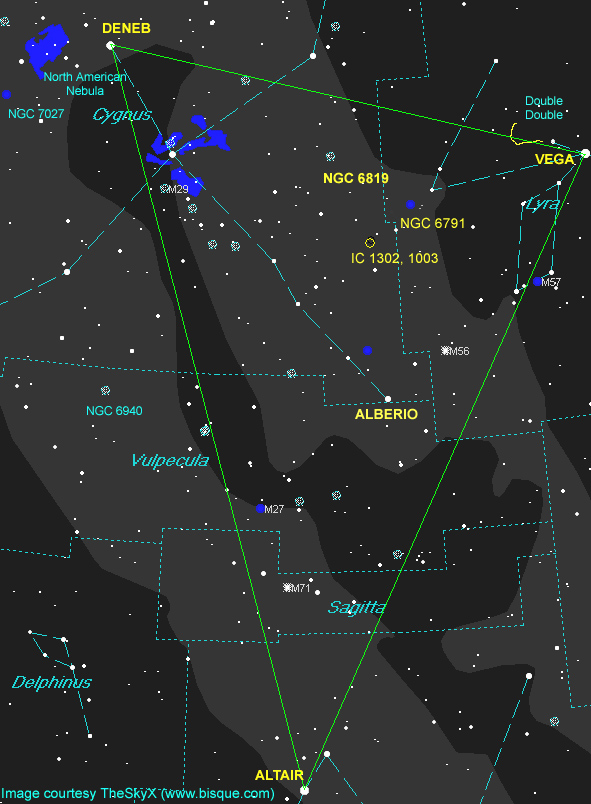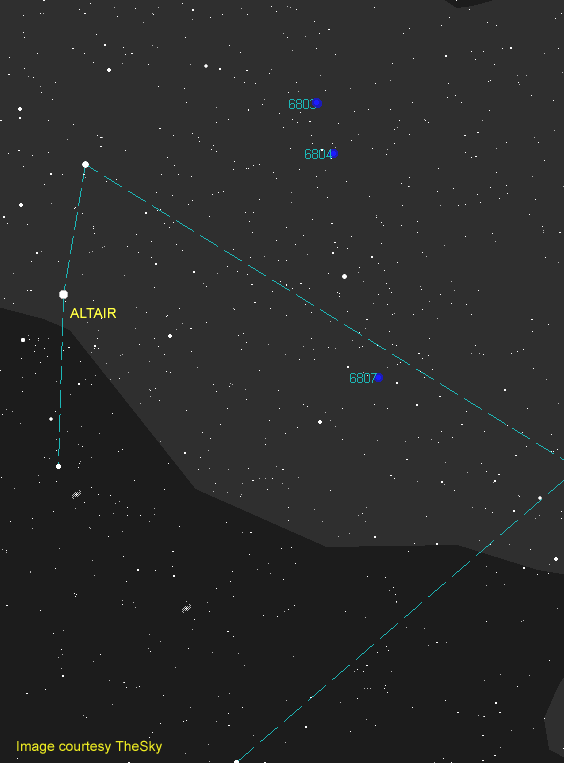The Summer Triangle – part 2
We now continue our tour of the famous summer triangle. Halfway between the Double-Double and Deneb is a dense magnitude 9.5 open cluster identified as NGC 6819. Pretty well any telescope will reveal about 30 stars but larger instruments are required to pick up the many fainter suns. NGC 6819 is located some 7,200 light-years and thought to be around 2.3 billion years old. Moving four and a half degrees to the west is another dense but extremely old open cluster. NGC 6791 lies 13,000 light-years from us but this old-timer is estimated to be around 8 billion years old or a little more than two-third the age of the known Universe from the Big Bang.
Even though the Milky Way is known mostly for open and globular clusters, there are a few galaxies in the mix, such as IC 1302 and IC 1303. In the case of IC 1303, this remote object is measured to be 194 million light-years away and at magnitude 14.2 will be a challenge to observe visually. Now let’s position ourselves at Alberio – that gorgeous double star at the head of Cygnus the Swan. Moving south to the star Altair, we must stop in Vulpecula the Fox. Here we spot a favourite at star parties catalogued M27. Commonly referred to as the Dumbbell Nebula, this fuzzy object is a planetary nebula or actually the remains of a star that has exhausted its internal fuel long ago. This is what our Sun will look like some 5 billion years from now (give or take a million). M27 is listed as magnitude 7.4 and lies about 1,200 light-years from us. Planetary nebulas produce unique and spectacular shapes. As the star spits out its last burst of energy, mysterious designs take shape.

About one third the way from M27 to the star Altair, we come across the high resolved globular cluster catalogued as M71 and this cluster lies in Sagitta the arrow, the third smaller constellation in the entire sky. Although well resolved, this magnitude 8.2 object is either considered to be a loose globular cluster or a dense open cluster. Any way you say it, M71 lies about 13,000 light-years away. And while on planetaries, there is a couple of dead star remains located about 5 degrees to the west of Altair and are within a degree of each other. First, we have NGC 6803 located 8,000 light-years away and glows at magnitude 10.5. A greater challenge will be NGC 6804 some 50 arc minutes to the south and is closer to 13th magnitude.
As mentioned last month, Comet C/2014 E2 Jacques is still putting on a good show as it now races through the Milky Way. This month it can be found riding along Cygnus the Swan which is directly overhead (zenith) around 10 p.m. local time. The comet will pass Deneb on the 4th and brushes by Alberio ten nights later. Although Jacques is moving quickly in the sky, it is getting fainter and the glare of the moon will not help in observing it visually.

The planets have always intrigued civilizations and it is amazing the majority of the general public do not know they can see the five wandering planets with the naked eye. For the next week or so Venus will be seen very close to the horizon in the east before sunrise with Jupiter much higher in the dawn sky. These are the brightest planets as seen from Earth. Saturn and Mars are separating and sinking in the west. A great web site to follow the planets and learn the nightly constellations is Heavens Above. Just select your location on Earth (bookmark it) and click on the link ‘Sky Chart’. You can now toggle the date and time at the bottom of the chart. If you are going to print charts to bring outdoors, be sure to click on the ‘black on white’ before print. Saves on ink and toner. This site also predicts when and where the International Space Station (ISS) will be in the sky for your city or town.
And here we are the end of summer - that is technically on the calendar as the Fall Equinox occurs on the 23rd at 2:29 UT which is the night of the 22nd here in Canada. Spring commences in the Southern Hemisphere. Another sure fired way to verify the change of seasons is our good buddy Orion the Hunter is well up in the dawn sky. In fact, the star Sirius (brightest star of Canis Major) creeps over the horizon at 4:30. Back in the days of antiquity farmers used the night sky to judge times to plant and harvest. Sirius was their sign to pick the crops as the flooding of the Nile and winter was around the corner.
Equinox refers to the time when Earth’s day and night time hours are the same whether it be spring or fall. It also means we are lined up with the plane of the solar system and can witness the line of interstellar dust called the Zodiacal lights. This ghostly glow can be seen and photographed from dark country skies and away from city lights. It is also best seen when the moon is absent. So this month’s two-week window commences on the 20th.
September’s full Harvest Moon occurs on the 8th at 21:38 eastern time and is the last of the so-called ‘super moons’ we had this year. The other two were July and August. A super moon is the combination of the Moon’s closest approach to Earth in its elliptical orbit around us and being at full phase. The Moon will be 355,584 km from Earth. However, it is actually closer to us a couple of hours prior. New Moon or lunation 1135 takes place on the 24th at 6:14 UT.
Until next month, clear skies everyone.
